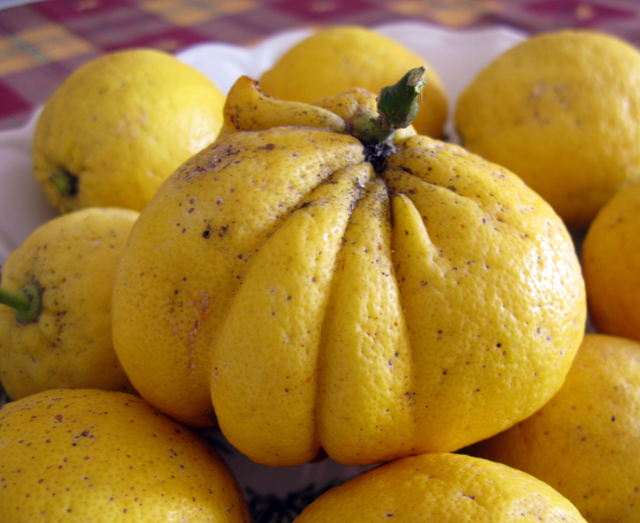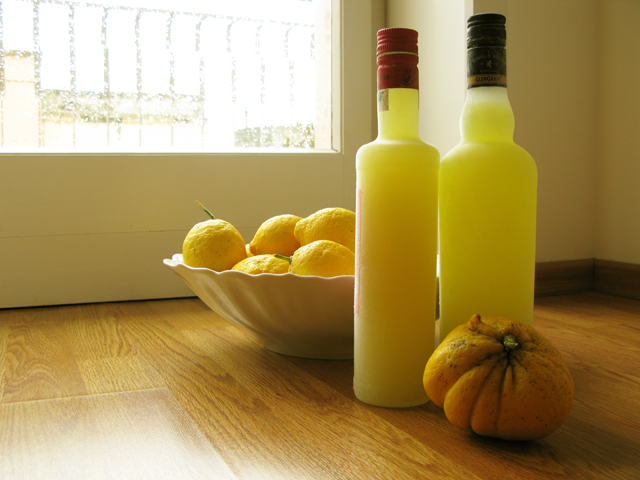 (images by Kate Bailward)
(images by Kate Bailward)
This post has been entered into the “Grow Your Own” roundup, created by Andrea’s Recipes and hosted this month by House of Annie.
Everywhere you turn at the moment there are oranges and lemons. A few weeks ago the Italian flatmate went to his nonna’s and came back staggering under the weight of oranges, fennel and puntarelle that she’d given him. The staff room fridge at school is stuffed to the gills with oranges, and the other day one of the teachers mentioned that she’d been picking lemons. I innocently asked if she could spare a few for me to make limoncello. The look of joy on her face should have alerted me: the next day she turned up with a shopping bag full of them. I only needed 3 or 4. Lemonade, anyone?
The best thing about using fruit straight from the tree is that it’s so imperfect and yet so good. None of it is the same size or shape, but it IS all delicious. There’s a strange beauty in the weird forms of these enormous, misshapen fruits. One looks more like a pumpkin than a lemon, while another looks like a speckled apple. You only have to get within 3 foot of them to know that your eyes are deceiving you, though: the scent coming off them is amazingly strong. When I peel a couple of them, the oil sprays off the skin in a fine, yet visible mist, and the smell pervades the entire flat for an hour afterwards. When I then cut the zested lemons into quarters to freeze them, the juice runs everywhere, dripping over the edge of the board and making a sticky, deliciously-scented mess. Going back to supermarket lemons, small, dry and hard, will be a wrench after this winter.
To make limoncello, you need 95% pure alcohol. Doubtful I’ll be able to get hold of that, I go to the supermarket in search of vodka. For a good five minutes I gaze glumly at the choice in Sidis, which is either dirt cheap (and therefore probably pretty akin to paint-stripper), already flavoured (useless to me) or decent and expensive, which I don’t really want to waste on an experiment. Finally, I decide on the paint-stripper version. At least if everything goes wrong I’ll only have paid out €7. About to head across to the checkout, I glance over to see if there’s any decent whisky on the shelf. No, there isn’t. But there IS pure alcohol! Hurrah! In three different bottle sizes, and dirt cheap. These Italians are crazy, but brilliant. Still, with all these oranges and lemons sitting around, I suppose everyone’s doing the same as me at the moment, and desperately trying to get rid of them. Operation Limoncello is most definitely ON.
I head back to the flat in a state of feverish excitement and start peeling lemons. The smell is delicious, but by god it takes ages to do. The recipe I’m using is very clear that you should take only the yellow zest, and none of the white pith. Well that ain’t never gonna happen. I do my best, but it’s nigh-on impossible not to end up a little bit pithed. (Arf.) I’ve decided to halve the quantities of the recipe for this first try, so I peel just 2 lemons and drop the zest into a large jar, along with a couple of leaves, then glug in one of the two 50cl bottles of booze that I’ve bought. In a frustrating delay to the story, this now all needs to be left to macerate for at least 48 hours. After this time, I can add the sugar syrup which will (hopefully) transform it from something probably disturbingly like lemon-flavoured turps to sweet, delicious, hopelessly alcoholic limoncello. Yum. A couple of hours later I glance at the jar, and notice that, already, the liquid has turned a pale yellow. That lemon oil is potent stuff, clearly. Every time I go into the kitchen and take a look the colour seems richer and deeper. It currently has an almost amber tinge to it, and there are still another 24 hours of steeping to go. I don’t think I’ve been this excited about making something since growing cress on a paper towel as 5-year old. And that wasn’t even alcoholic.
After 72 hours (I got distracted, OK?), I get around to making up the sugar syrup to add to the by now bright yellow liquid. The zest has turned almost completely white, and even the green of the leaves has faded a bit. I’m nearly as fascinated by the process as by the end result. That’s *nearly* – ultimately, there’s no getting between a greedy woman and her digestivo. I stick a colander over the pan in which I made the sugar syrup, to catch the zest and leaves, and pour the lemony booze through it. Removing the colander, I peer into the pan and grin with excitement. Pre-mixing, the alcohol was clear, as was the sugar syrup. Now, however, the mixture is cloudy, acid-yellow with a tinge of green to it. The most exciting bit, however, is decanting it into bottles. It suddenly all looks really professional: if I could give myself a smug pat on the back, I would. I settle instead for a taste test, sipping the final double-espresso-cup’s worth that wouldn’t fit into the bottles. I pass the cup over to Alex. He sniffs it doubtfully, and peers dubiously at it. “Well, it *smells* like limoncello, and it *looks* like limoncello …” With a nervous squaring of his shoulders, he takes a tiny sip. An incredulous grin spreads across his face and he takes a rather larger mouthful. “It even TASTES like limoncello!” We finish the cup, giggling like naughty schoolchildren. The Limoncello experiment is most definitely a success. So now, about those oranges …
 Recipe (with thanks to AmyAmy’s nonna):
Recipe (with thanks to AmyAmy’s nonna):
Take 2 lemons, fresh from the tree. Taking care to leave behind the white pith, remove the yellow zest and drop it into a large jar, along with one leaf. Cover with 50cl of pure alcohol (95%), screw on a tight-fitting lid to stop the alcohol evaporating, and leave for at least 48 hours.
After 48 hours, make up a sugar syrup. Heat 750ml of water to nearly boiling, then turn off the heat and add 300g of sugar. Stir until the sugar dissolves. Leave to cool.
When the sugar syrup is cold, pour the alcohol into the pan, catching the zest and leaves in a colander. Stir the liquids to combine.
Using a funnel lined with muslin, pour the limoncello into bottles and seal tightly. Drink at will.







Pingback: Five gold rings – Driving Like a Maniac